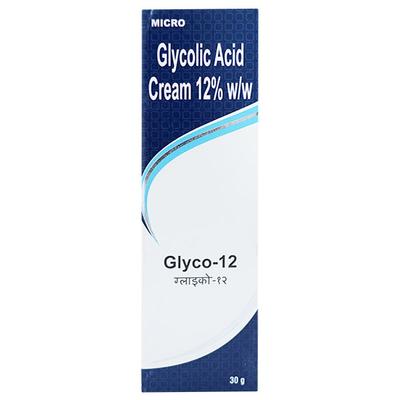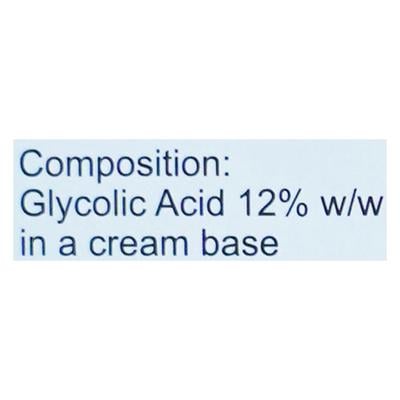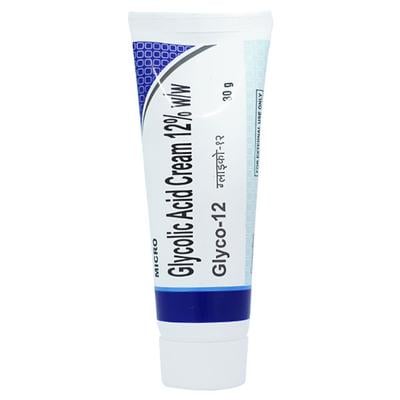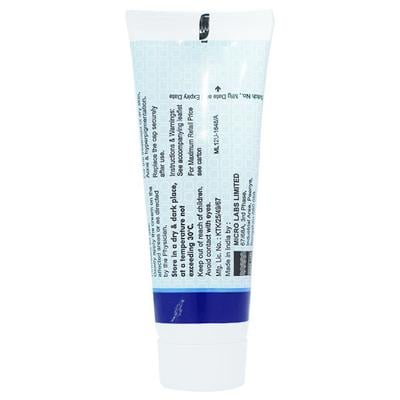

Netmeds First Membership
Quick Links
Introduction About GLYCO 12% CREAM
Glyco 12 Cream is a skin cream which is used for the management of skin dryness, acne, and hyperpigmentation. It contains Glycolic Acid as an active ingredient which is an alpha-hydroxy acid that exfoliates the skin and makes it brighter.
Glycolic acid helps in managing hyperpigmentation by suppressing the formation of melanin (skin pigment) by inhibiting tyrosinase activity. It also exfoliates the skin by enhancing the desquamation of the upper skin layer.
Always apply Glyco 12 Cream as directed by your physician. It is for external use only. Clean the affected area and apply a thin layer of Glyco 12 Cream gently on the affected area during the night. Do not exceed the daily recommended dosage. Avoid exposure to sunlight and contact with eyes. Do not apply this cream if you have contact dermatitis (skin inflammation- skin rash, blisters, dry and cracked skin).
Key Composition
- Glycolic acid
Therapeutic Uses Of GLYCO 12% CREAM
It is used for management of skin problems such as:
- skin dryness
- comedonal acne (when skin pores are clogged by bacteria, oil, and dead skin cells)
- post acne hyperpigmentation
- facial hyperpigmentation
Side Effects Of GLYCO 12% CREAM
Glyco 12 Cream may cause a burning sensation, pain, swelling, skin redness, blisters, or vesicles. Consult with your doctor if you notice any such side effects while using it.
Safety Advice
- Always apply Glyco 12 Cream as directed by your physician/dermatologist
- It is for external use only
- Clean the affected area and apply thin layer of this cream gently on affected area during night
- Do not exceed the daily recommended dosage
- Avoid exposure to sunlight and contact with eyes
- Do not apply this cream if you have contact dermatitis (skin inflammation- skin rash, blisters, dry and cracked skin)
- Glyco 12 Cream can increase sensitivity to the sun therefore use sunscreen, wear protective clothing, or avoid going out in sun after applying for this medicine
- Do not use this cream if you are allergic to any of its ingredients
- It is not recommended for use in pregnant and breastfeeding women, therefore, inform your doctor if you are pregnant, planning a pregnancy or breastfeeding before applying it
- It is not recommended for use in children
- Inform your doctor regarding all the medicines you use, including prescription, over-the-counter medications, and herbal supplements
More Information
- Keep Glyco 12 Cream out of reach and sight of children
- Store at room temperature
FAQs About GLYCO 12% CREAM
Q: How to use Glyco 6 Cream on the face?
A: Glyco 6 Cream is for external use only. Apply as directed by your physician. Clean the affected area and apply a thin layer of this cream gently on the affected area during the night.
Q: What precautions should I take while using Glyco 6 Cream?
A: Glyco 6 Cream contains alpha-hydroxy acids (AHAs) that can increase your sensitivity to the sun therefore use sunscreen, wear protective clothing, or avoid going out in sun after applying this cream.
Q: Does Glyco 6 Cream helps fade dark spots?
A: Yes. Glyco 6 Cream helps in managing hyperpigmentation by suppressing the formation of melanin (skin pigment) by inhibiting tyrosinase activity. This fades the dark spots and brightens the skin.
Q: Is it necessary to apply moisturizer after using Glyco 6 Cream?
A: Moisturiser can be used post-application of Glyco 6 Cream. Preferably, you should consult with your dermatologist before applying it, especially if has to apply to your face.
Q: Can I leave Glyco 6 Cream overnight?
A: Yes. Glyco 6 Cream can be left on your face overnight if and let it absorb into your skin. Wash it out the next day with water. Look out for signs of skin irritation, if this occurs stop using the cream.
References
- A Perez-Bernal, M A Munoz-Perez, F Camacho. Management of facial hyperpigmentation. NIH. National Library of Medicine, NCBI. Pubmed. [Revised in October 2000]. [Accessed on 7th August 2025]

- Jaishree Sharad. Glycolic acid peel therapy – a current review. NIH. National Library of Medicine, NCBI. Pubmed Central. [Revised in November 2013]. [Accessed on 7th August 2025]














